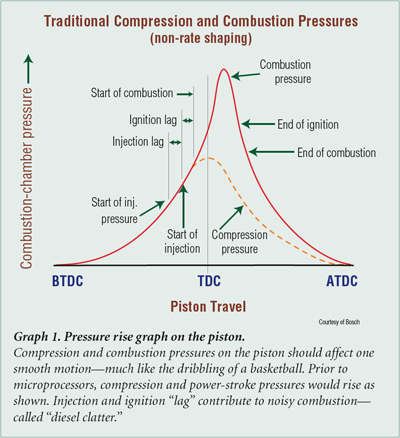But the SD like nearly all other InDirect Injection (IDI) engines already has 22:1 compression AND in the SD's case a high amount of base timing (20 degrees BTDC).
The "problem" I have is there is now a lot of transient, loud, sharp cackle/combustion knock at idle and at lower engine speeds UNTIL ... the engine coolant temperature gets up above approx 140 degrees F.
Researching the matter came up with a phenomenon called "Ignition Lag." This is a phenomenon where the amount of time from the moment fuel begins to be injected until it ignites occurs closer to TDC than intended.
It seems that a cold prechamber, cylinder head, and piston contribute greatly to this "ignition lag". So under this condition, when the mixture does ignite, the piston is closer to TDC (making the cylinder pressure higher when ignition finally does occur) and there is more fuel present which promotes a violent flame propagation.
As the engine coolant temperature rises, ignition lag is reduced which in turn slows the rapid pressure rise when combustion begins because the piston is further from TDC (lower cylinder pressure at the moment of ignition) and there is less fuel in the cylinder at the moment ignition begins. For lack of better terminology, combustion goes from being a violent pop to a predictable and slower burn.
Here's a graph with an explanation. (It's all on the Internet, right?)

Ignition Delay
The time between the start of injection and the start of combustion is referred to as the ignition delay. The delay is primarily a function of the parameters that affect the chemical reaction rate of the fuel-vapor mixtures. The parameters that most affect ignition delay in open-chamber engines are temperature and pressure of the air during the delay period and the chemistry of the fuel.
The major reason that long ignition delays occur in a cold combustion chamber is that a large amount of fuel vaporizes and mixes with air before ignition takes place. When ignition begins, the vaporized fuel and air mixture burns rapidly, producing a large pressure rise, a high peak pressure, and a particular sharp knocking sound. Ignition delay can lead to mechanical failure and/or failure to meet noise control standards.
Ignition delay can be reduced by retarding injection timing, applying exhaust recirculation systems, or by heating the inlet air. These solutions can also lead to reduction in performance and/or an increase in unwanted emissions.
Formulas to predict ignition delay have been obtained from engine and bomb tests, however the inexact nature of determining the start of injection, start of ignition and the temperature of the region of ignition produce uncertainties and lack of agreement when applied from engine to engine. Given these uncertainties, the ignition delay formulas are mainly used to predict trends unless specific correlation data for an engine and fuel have been obtained.
From this explanation, I gather that in examples where the base timing setting is overly retarded for a normal temperature engine (lower NOx), then -advancing- the base timing when the engine is cold should improve driveability but ... must be backed down as the engine warms.
In the SD's case, the base timing is set at maximum tolerable advance for a normalized engine temperature. This makes for high NOx emissions but is offset to some degree by throttling the air supply thereby reducing compression and NOx. As such, the high amount of base timing easily tolerated by normalized engine temperature now contributes to "cackle / knock" when cold combustion chamber surfaces extend the "ignition delay" phenomenon. I've also discovered cetane improver fuel additives worsen cold engine combustion cackle / knock depending how how much you add to the fuel. Adding ASTM biodiesel has a very similar effect.


